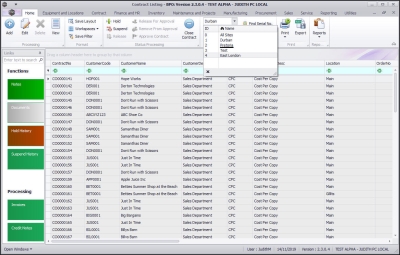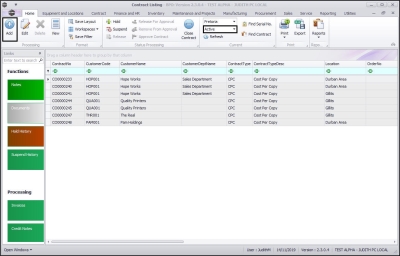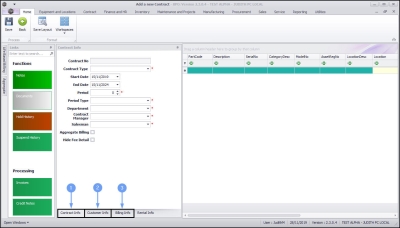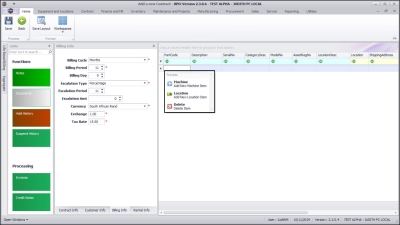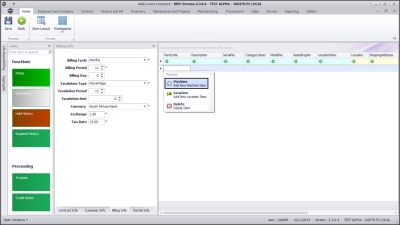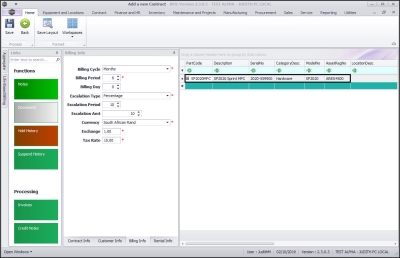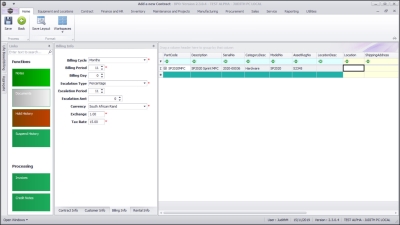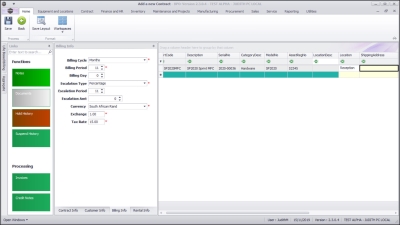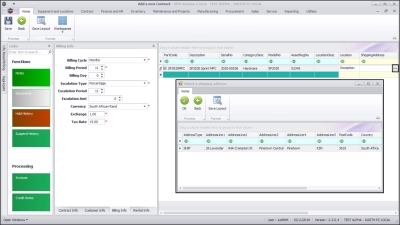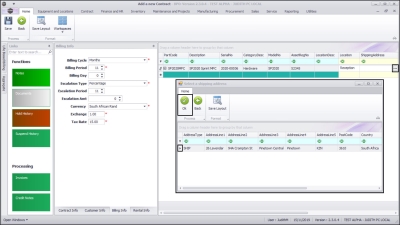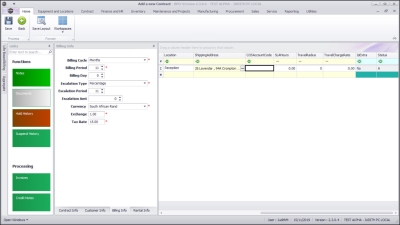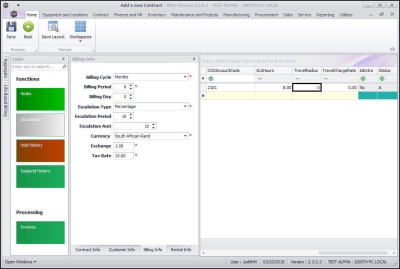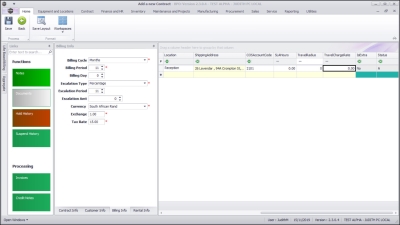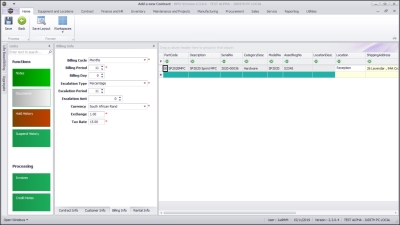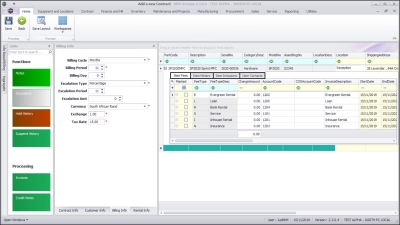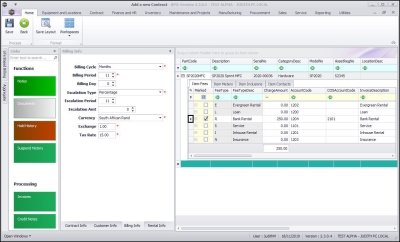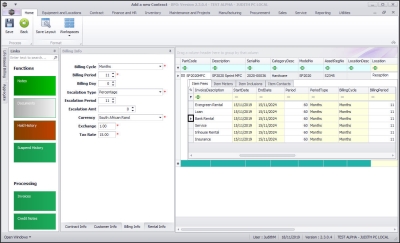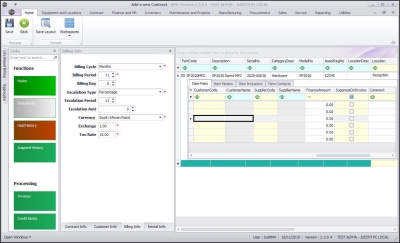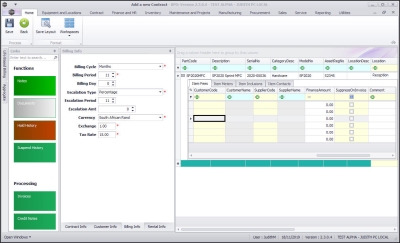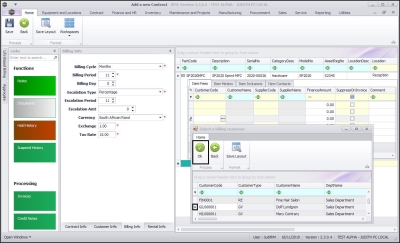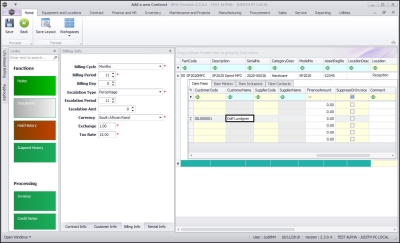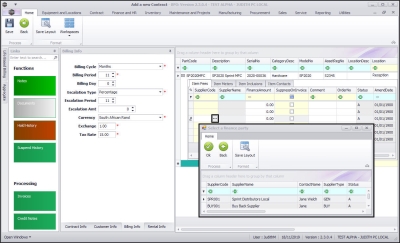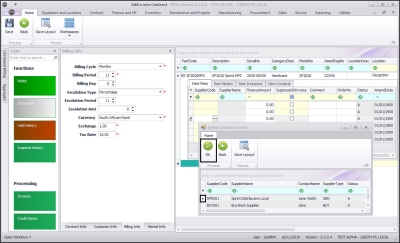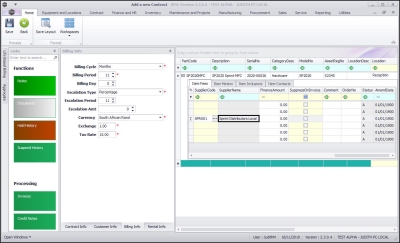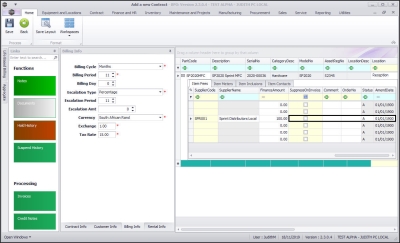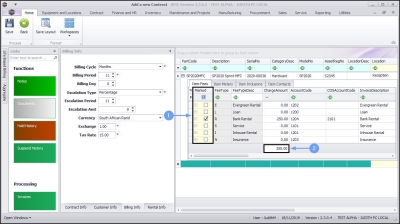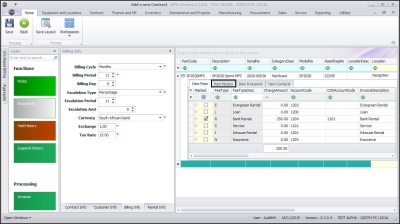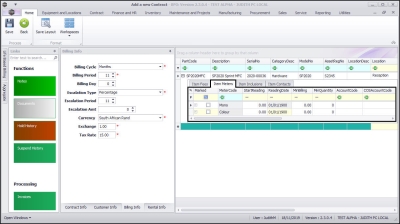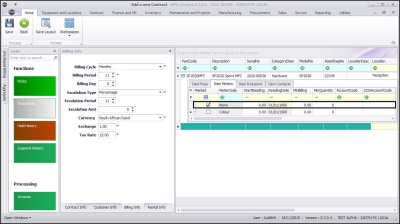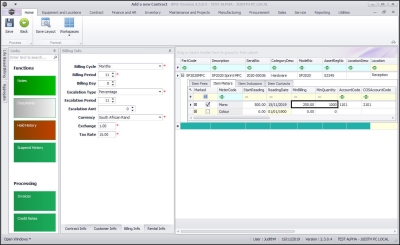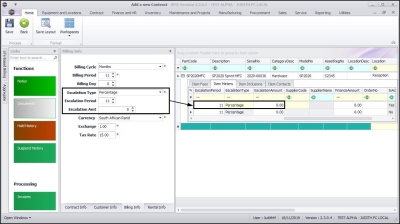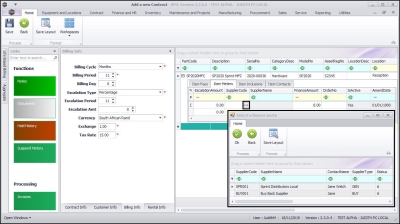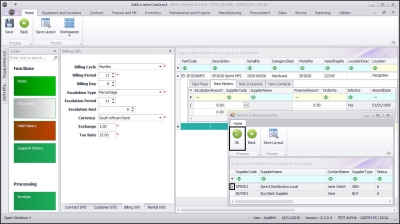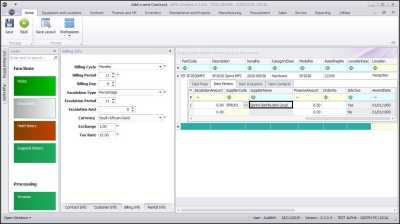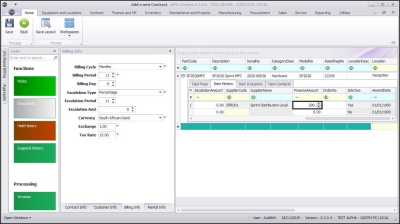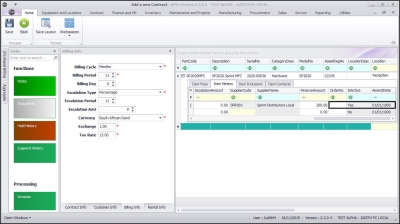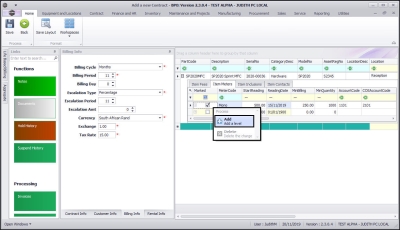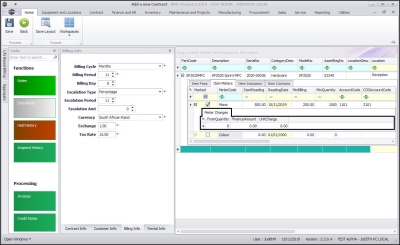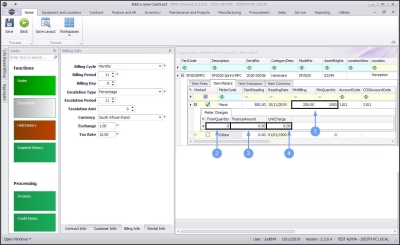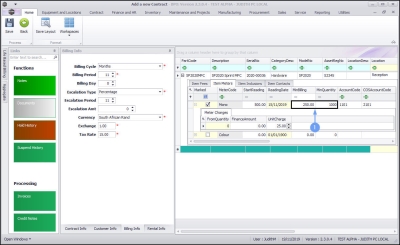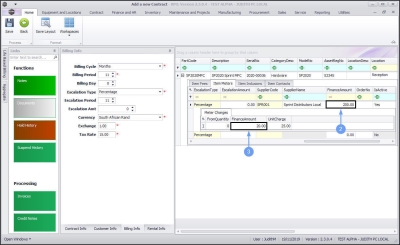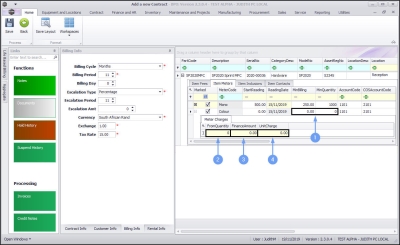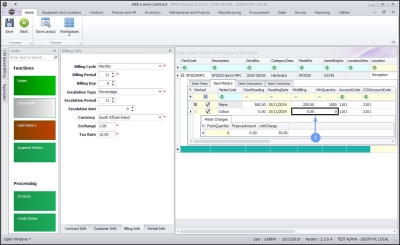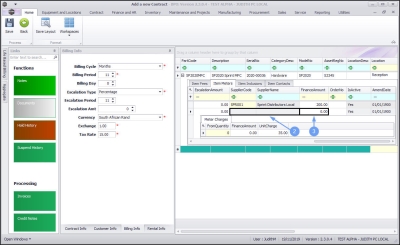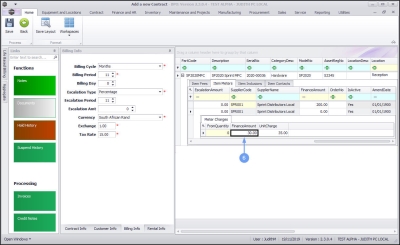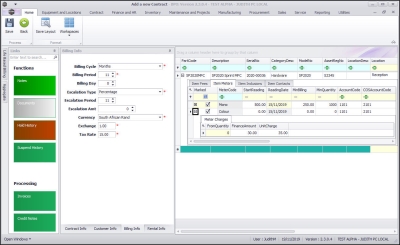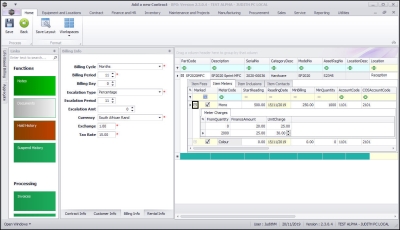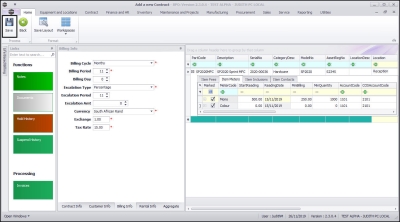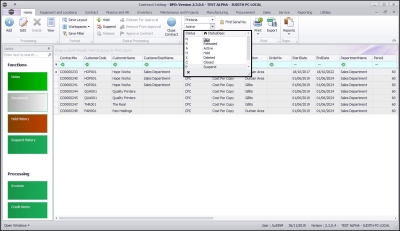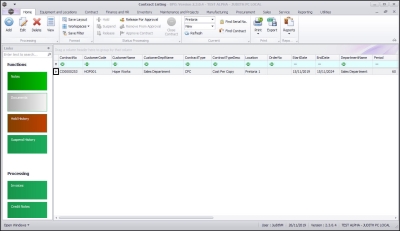We are currently updating our site; thank you for your patience.
Contract
Back To Back Contract - Standard Contract Setup
A back to back contract set up is a contract where you bill a customer and pay part of the amount to a supplier / third party.
A Back to Back Contract can be set up for a standard contract as set out below or for an aggregate or prepaid contract.
| Ribbon Access:Contract > Contracts |
The Contract Listing screen will be displayed.
- To select the Site that you wish to work in, click on the drop-down arrow and select the relevant site.
- In this image Pretoria has been selected.
- By default, this screen will list all the Active contracts for the selected site.
- You do not need to change this status to create / add a new contract.
- Click on Add.
The Add a new Contract screen will be displayed.
Information Panels
Contract Parts Frame
- Right click anywhere in the row of the Parts frame.
- A Process menu will pop up.
- From this menu, you can:
Add Machine Item
- Click on Machine - Add New Machine Item.
- The Select a new item pop up screen will appear.
- Select the row of the machine that you wish to link to this contract.
- Click on Ok.
- The following columns will auto populate according to your item selection:
- Part Code
- Description
- Category Description
- Model No
- Serial No
- Asset Register No
- Click in the Location text box. This is the location of the contract item e.g., Reception or First Floor.
- Type in a location for this item.
- Note 1: Linking a Location to the contract item will make it easier for the technician to locate the contract item when they need to attend to it.
- Note 2: Location Desc field is greyed out. This field is only populated when adding a new location item.
- Click in the Shipping Address text box.
- This is the address where the machine is actually located.
- An Ellipsis button will be revealed.
- Click on this button to display the Select a shipping address pop up screen.
- Select the row of the shipping address that you wish to link to this item.
- Click on Ok.
Scroll right to view the remaining columns in the Items frame.
- Click in the COS Account Code text box.
- Type in the Cost of Sales account code to be used for WIP (Work In Progress) transaction postings (non-billable toner and spare parts issued as contract included items).
- Click in the SLA Hours text box.
- Type in or use the arrow indicators to select the required call response time (in hours) if applicable.
- Note 1: If this is set up, SLA will apply every time a call is logged against the contract item. SLA will be calculated based on the shift pattern (customer's trading hours) e.g., if the trading hours are from 8am - 5pm and a call is logged at 4pm, SLA will start calculating at 4pm and stop at 5pm and resume the following day at 8am.
- Note 2: For SLA to work, the shift must be set up in BPO Configurator and linked to the customer.
- Click in the Travel Radius text box.
- Type in or use the arrow indicators to select the distance in km to and from the client, if this travel is to be billed every time a call is logged. If travel is included, then set this to 0.
- Note: Travel can always be billed separately, if required.
- Click in the Travel Charge Rate text box.
- Type in or use the arrow indicators to select the travel charge rate (e.g., Rand per km).
- Note: If you input a non zero value, each time a call is logged against the contract item and the technician travels outside the specified Travel Radius, the Travel Charge Rate will be applied. You will not be able to close the Call until the travel charges incurred are invoiced.
- The Is Extra and Status fields are static.
Scroll left, so that you can view the Part Code column again.
Part Items Frames
- Click on the expand button in the Part Code text box.
The Item frames for the selected machine will be expanded. Here you can click on 4 different tabs to add or edit the frame information:
- Item Fees: These are periodic charges e.g., a monthly service fee.
- Item Meters: These are meter usage charges.
- Item Inclusions: These are non billable items that are included in the contract.
- Item Contacts: This the contact person - per machine.
Add Item Fees
The Item Fees frame displays Contract Item Fees that can be linked or are linked to a contract item e.g., a machine. Item Fees linked to a contract item will appear on the contract invoice when billing.
- Marked: Select the check box in front of the Item Fee Type to be charged on the contract item.
- In this image, R - Bank Rental has been selected as an example.
- Charge Amount: Type in or use the arrow indicators to select the fee amount to be charged.
- Account Code: This will auto populate with the account code linked to this fee item.
- COS Account Code: Type in the cost of sale account code where this fee should be posted to.
- Invoice Description: Type in the description to be used for this fee on the invoice. The description will reflect on the contract invoice.
Scroll right to view the remaining columns in this frame.
- Start Date and End Date: These will auto populate according to the contract start date and end date selected in the Contract Info panel. You can click on the drop-down arrow and use the calendar function to select an alternative start and end date if required.
- Note: Take note that the contract fee will only bill from the start date, and will stop billing at the end date.
- Period & Period Type: These fields will auto populate according to the contract start and end date recorded in the Contract Info panel. You can click on the text boxes and either type in or use the drop-down arrows to select an alternative period and period type if required.
- Billing Cycle: This will auto populate according to the contract billing cycle recorded in the Billing Info panel. You can click on the text boxes and either type in or use the drop-down arrow to select an alternative billing cycle if required.
- Billing Period: This will auto populate according to the contract billing period recorded in the Billing Info panel. You can click on the text boxes and either type in or use the drop-down arrow to select an alternative billing period if required.
Scroll right to view the remaining columns in this frame.
- Escalation Period: This will auto populate according to the escalation period recorded in the Billing Info panel. You can click on the text boxes and either type in or use the drop-down arrow to select an alternative escalation period if required.
- Escalation Type: This will auto populate according to the escalation type recorded in the Billing Info panel. You can click on the drop-down arrow in the text box to select an alternative escalation type if required.
- Escalation Amount: This will auto populate according to the escalation amount recorded in the Billing Info panel. You can click on the text box and either type in or use the arrow indicators to select an alternative escalation amount if required.
Alternative Billing Customer - Fees
Customer Code and Customer Name
- Only populate these 2 fields if another party (a separate billing customer) is going to pay the Item Fees on behalf of the customer.
- If these fields are left blank, BPO will bill the customer linked to the contract.
- Note: Follow the next 4 screen shots only if you wish to link another party as the billing customer.
- Click in the Customer Code text box.
- An Ellipsis button will be revealed.
- Click on this button to display the Select a billing customer pop up screen.
- Select the row of the Billing customer you wish to link to this contract.
- Click on Ok.
- Customer Name: Once you have selected the customer code, the customer name will auto populate with the customer name linked to that code on the system.
Back To Back Item Fees Set Up
For a Back to Back contract to work, the following fields must be populated:
- Supplier Code
- Supplier Name
- Finance Amount
Supplier Code
- Click on the Supplier Code text box to reveal an ellipsis button.
- Click on this button to display the Select a finance party pop up screen.
- Select the row of the Supplier that you wish to link to this item.
- Click on Ok.
Supplier Name
- This will auto populate once the supplier code has been selected.
Finance Amount
- Click in this text box and either type in or use the arrow indicators to select the finance amount. This amount will be collected from the billing customer and will be paid to the linked supplier.
- Suppress on Invoice: Select this if you wish to hide the item fee information on the invoice.
- Comment: Click in this text box and type in a comment regarding this contract fee, if required.
- Order No: Type in a customer order number relevant to this item, if required.
- Status: This field defaults as A (Active) and is static.
- Amend Date: This field is static.
The Add an Item Fee process is now complete.
Link Additional Item Fees
Scroll back to the Marked column.
- You can now set up additional fees for this machine by following the same process as above, if required, before moving on to the next frame.
- This shows the total amount of all Item Fees charged on the contract item.
Add Meter Charges
- When you have finished working in the Item Fees frame, click on the Item Meters tab if you are going to bill meters.
The Item Meters frame displays all linked meters on the contract item.
You can set minimum billing and meter usage charges for the contract item in this screen.
- Note 1: If there are no meters linked to the contract item, you can move to the next step of setting up the contract and link the meters and meter charges afterwards by following these 2 steps:
- Note 2: To avoid linking up meters to items every time you want to add items on a contract, link meters to the part codes of the items. This way, when new items are received / adjusted into stores, they will already have meters linked to them. (This will not apply to items that are already in stores prior to this step.)
- Marked: Click on the check box in front of the name of the Meter to be billed on this contract.
- In this image the Mono meter has been selected as an example.
- Start Reading: Type in the start reading of the meter. This will be the reading taken from the contract item.
- Reading Date: Click in this text box to display the calendar function, use this to select the reading date.
- Min Billing: Type in the minimum billing amount.
- Minimum billing is a fixed charge; levied on any number of copies made from 0 up to and including the Minimum Quantity. For example, a minimum billing fee of R250 for a minimum quantity of 1000 copies means R250 will be charged for any number of copies made from 0 up to and including 1000.
- If no minimum billing should be applied, leave the MinBilling and MinQuantity fields as 0.
- For a more detailed explanation, read this Important Note on Minimum Billing and Meter Charge Setup.
- Min Quantity: Type in the minimum quantity (the copies that are included in the minimum billing amount).
- Account Code: Type in the sales account code for these meter charges to be posted to.
- COS Account Code: Type in the cost of sale account code where this fee should be posted to.
- In this example of the Mono Meter; the minimum billing amount charged is R250 for a minimum quantity of 1000 copies.
Alternative Billing Customer - Meters
Customer Code and Customer Name:
- Only populate these 2 fields if another party (a separate billing customer) is going to pay the Item Meter Fees on behalf of the customer.
- If these fields are left blank, BPO will bill the customer linked to the contract.
Follow the next 4 screen shots only if you wish to link another party as the billing customer.
- Customer Code: Click in this field.
- An ellipsis button will be revealed.
- Click on this button to display the Select a billing customer pop up screen.
- Select the row of the Billing customer that you wish to link to this contract.
- Click on Ok.
- Customer Name: Once you have selected the customer code, the customer name will auto populate with the customer name linked to that code on the system.
- Escalation Period, Escalation Type and Escalation Amount: These will pull through from the main contract details but you can click in the text boxes and amend the details if required.
Back To Back Item Meters Set Up
For Meters with Minimum Billing
- Supplier Code:
- Click on the Supplier Code text box to reveal an ellipsis button.
- Click on this button to display the Select a finance party pop up screen.
- Select the row of the Supplier that you wish to link to this item meter.
- Click on Ok.
- Supplier Name: This will auto populate once the supplier code has been selected.
- Finance Amount: Click in this text box and either type in or use the arrow indicators to select the finance amount. This amount will be collected from the billing customer and will be paid to the linked supplier.
- In this example, a fixed financing amount of R200 will be charged for any number of copies made on the mono meter from 0 up to and including the minimum billing quantity (in this case from 0 up to 1000 mono copies).
- This means R200 will be collected from the billing customer and will be paid to Sprint Distributors Local.
- Order No: Type in a customer order number relevant to this item, if required.
- Is Active: This field is set to Yes (Active) once you have clicked on the Marked check box.
- Amend Date: This field is static.
Add Meter Levels
- Scroll left to return to the Marked column.
- Right click in the row of the 'selected / active' item you wish to add a meter level to.
- A Process menu will pop up.
- Click on Add - Add a level.
You can add a meter level for either a meter with minimum billing or for a meter with no minimum billing.
Meters With Minimum Billing
- The Meter Charges frame will be expanded.
- Note: The Mono meter will be used as an example.
- In this image, the mono meter has a minimum billing of R250 for 1000 copies ( Minimum Quantity ). BPO calculates the usage charges by first calculating the minimum billing set up. In this example, it means in BPO, a fixed charge of R250 will be charged for any number of mono copies made on this contract item from 0 up to and including 1 000 thereafter a unit charge per copy will be applied i.e from 1001.
- From Quantity: This is the number from which the unit charge will be effective.
- The first row in the Meter Charges matrix, is static at 0. This means if there is minimum billing set up on the meter, the first row looks incorrect as the From Quantity field is static at 0.
- If there is minimum billing set up on the meter, BPO does not read the From Quantity in the first row as 0 (although it displays as 0) but starts counting from ( Minimum Quantity + 1). In this case, since (minimum billing level) is up to and including 1000, BPO will start counting from 1001.
- For a more detailed explanation, read this important note on Minimum Billing and Meter Charge Setup.
- Finance Amount: Type in the finance amount for the meter level (finance charge per copy when Minimum Quantity is exceeded). This amount will be collected from the billing customer and will be paid to the linked supplier.
- Note: Refer to Back To Back Meter Level Set Up For A Meter With Minimum Billing for a detailed explanation.
- Unit Charge: Type in the unit charge for the meter level (charge per copy when Minimum Quantity is exceeded).
Back To Back Meter Level Set Up
Meter With Minimum Billing
- If a meter has minimum billing
- and a finance amount set up on the minimum billing level, this means a fixed finance amount will be charged for any number of copies made on the selected meter from 0 up to and including the minimum quantity.
- In this example, it means a fixed finance amount of R200 will be charged for any number of copies made from 0 up to and including 1000 mono copies made.
- Setting up a finance amount at the meter level means once the minimum quantity has been exceeded, a finance amount will be charged per copy made on the selected meter. This amount will be collected from the billing customer and will be paid to the linked supplier.
- In this example, 20c will be charged per mono copy made once the minimum quantity has been exceeded i.e. from 1001 copies.
- Note: Scroll right if you cannot view the Finance Amount column in this frame.
- Scroll left until you can view the Marked column in this frame. Click on the hide button to close the Meter Charges matrix.
- You can add additional charge levels.
Add Meter Levels - Meter With No Minimum Billing
- The Meter Charges frame will be expanded.
- Note: The Colour meter will be used as an example.
- There is no minimum billing set up on this meter. This means the usage calculation will only be based on what's set up in the Meter Charges matrix.
- From Quantity: This is the number from which the unit charge will be effective.
- The first row in the Meter Charges matrix, is static at 0.
- For a more detailed explanation, read this important note on Minimum Billing and Meter Charge Setup.
- Finance Amount: Refer to Back To Back Meter Level Set Up For A Meter With No Minimum Billing for a detailed explanation.
- Note: This amount will be collected from the billing customer and will be paid to the linked supplier.
- Unit Charge: Type in the unit charge for the meter (charge per copy).
Back To Back Meter Level Set Up For Meter - No Minimum Billing
- For a meter with no minimum billing
- link the required Supplier and
- leave the Finance Amount as 0 at the minimum billing level.
- Note: Scroll right if you cannot view the Finance Amount column in this frame.
- In this image, Sprint Distributors Local has been linked as the supplier and
- the Finance Amount has been left as 0 at the minimum billing level.
- After linking the supplier, go to the Meter Charges matrix and set up the finance amount per copy.
- Finance Amount: Type in the finance amount for the meter level (finance charge per copy). This amount will be collected from the billing customer and will be paid to the linked supplier.
- Scroll left until you can view the Marked column in this frame. Click on the Hide button to close the Meter Charges matrix.
- You can add additional charge levels.
Add Additional Charge Level - Back To Back Set Up
- Right click anywhere in the row of the item that you wish to add another meter level to. (You can do this whilst the meter charges matrix is open or closed).
- Note: The Mono meter will be used as an example.
- The Process menu will pop up again.
- Click on Add - Add a level.
- A second level has now been added to the Meter Charges matrix.
- From Quantity: Type in or use the arrow indicators to select the number of copies from which this charge will be effective.
- For a more detailed explanation, read this important note on Minimum Billing and Meter Charge Setup.
- Finance Amount: Type in or use the arrow indicators to select the finance amount for this additional meter level (finance amount per copy). This amount will be collected from the billing customer and will be paid to the linked supplier.
- Note: This charge will usually increase with each new level.
- Unit Charge: Type in or use the arrow indicators to select the unit charge for this additional meter level (charge per copy). This charge will usually increase with each new level.
- Repeat this process to add more meter charges as required.
- When you have finished working in the Meter Charges matrix, click on the Hide button to close the frame.
Save the Contract
- Add contract inclusions if applicable and item contacts.
- When you are finished, click on Save.
- The new contract will be saved and you will return to the Contract Listing screen where the status defaults to Active.
- Click on the drop-down arrow in the Status field and select status - New.
- The new contract can be found within the New contract status listing screen.
- From here the contract will need to be Released and then Approved before it becomes active.
Important Note
- After billing back to back contracts, remember to create back to back supplier invoices for the suppliers linked to the back to back contracts.
MNU.112.056

